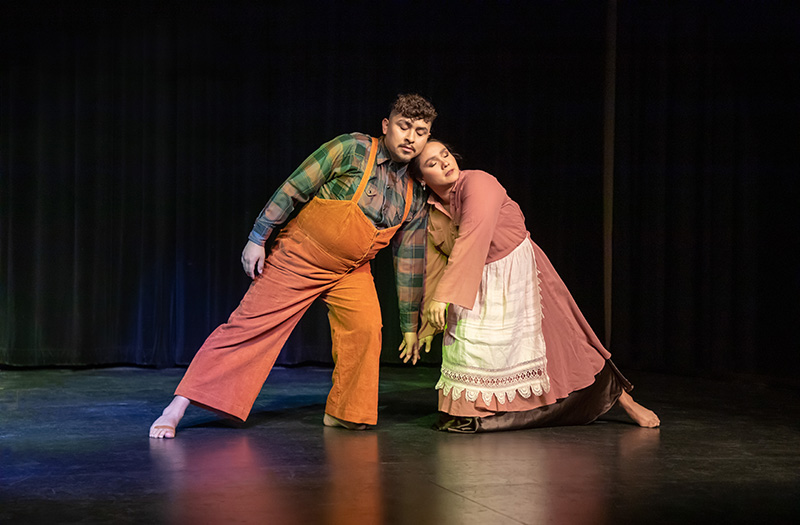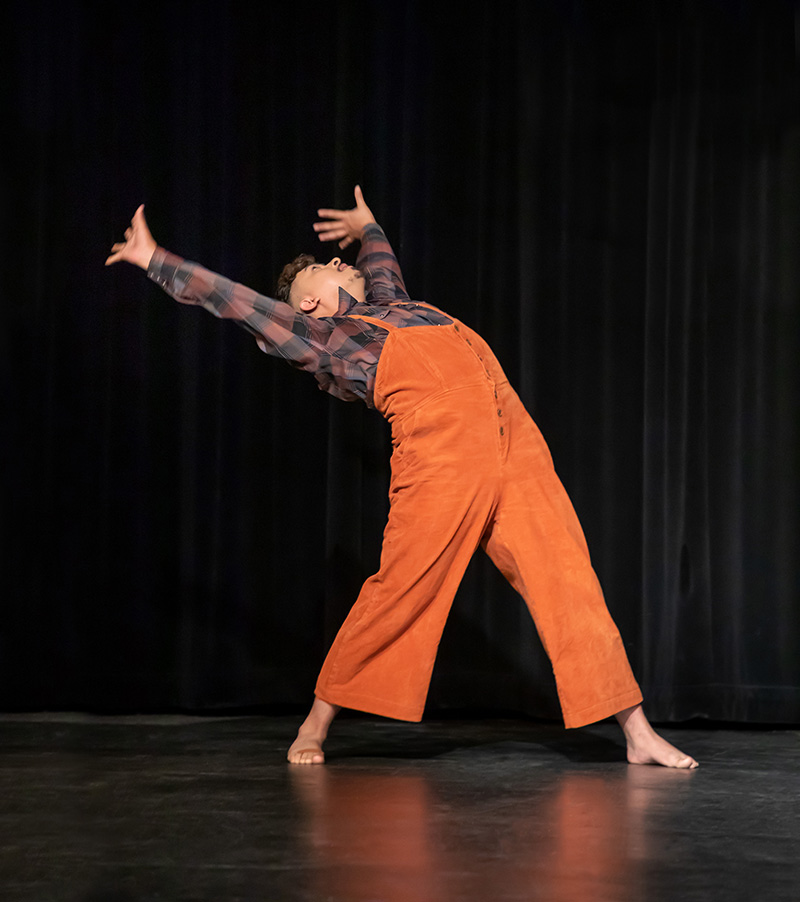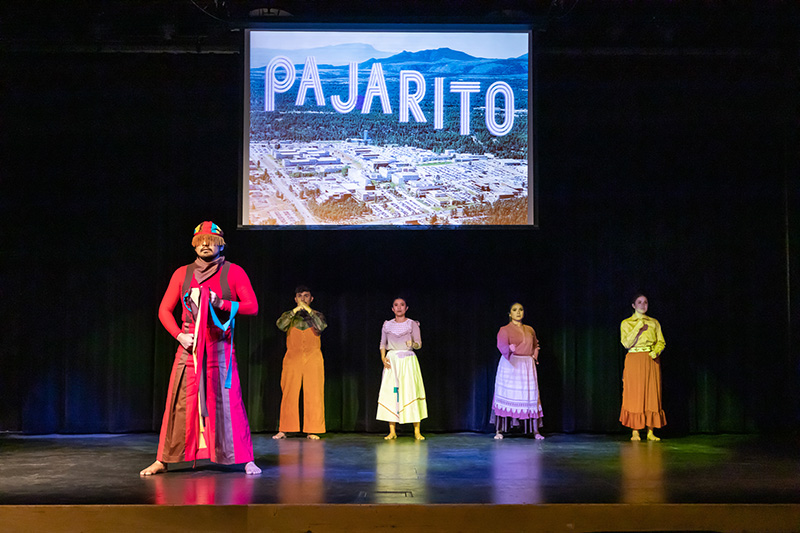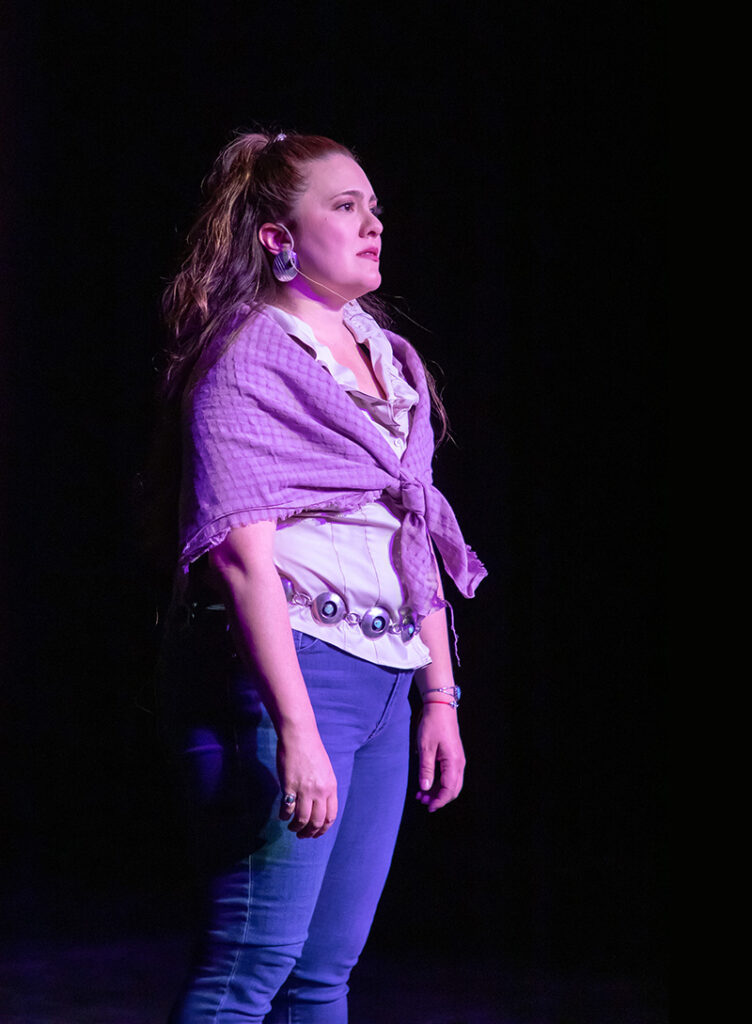Telling Her Family’s Story through Dance
An Interview with Yvonne Montoya
BY EMMALY WIEDERHOLT
Yvonne Montoya is a choreographer currently based in Arizona with a long family history in Northern New Mexico. She is a 23rd generation Nuevomexicana and a decedent of the Mexicanos that the border crossed in 1848. Her newest work, Stories from Home, dances the oral traditions of Northern New Mexico, as well as tells more specific stories of her family history, like working as migrant farmworkers or being displaced by the Manhattan Project. Here, she details why this specific culture and history feels important to share, and what performing it in New Mexico means to her.
All photos from“Pajarito” in Stories from Home by Yvonne Montoya. Photos by Dominic AZ Bonuccelli.

~~
What is the driving motivation behind Stories from Home? I understand it has had a few iterations over the years.
Stories from Home is a series of dances that are the physical embodiment of the oral traditions of Northern New Mexico, where I’m from and where my family has been for many generations. I was inspired to create Stories from Home after my father passed away in 2015. He was one of those old school Nuevomexicanos who was a storyteller and knew so many stories about his uncles, his dad, and my childhood. When he passed away, all those stories went with him. I grieved not only for his passing but for the disconnect with my ancestors. My son was only seven at the time, and I have younger nieces and nephews. They weren’t going to grow up with those stories. I realized it was my turn to be the storyteller and capture my family stories. I wanted to do that using the language I love most, which is dance.
There have been multiple iterations because of the pandemic. I started working on the choreography in 2017 at the SPACE on Ryder Farm Family Residency in Brewster, New York. We were all set and on track to debut the show in September 2020, but the pandemic happened. Everything was paused. I wasn’t quite sure what to do. I knew some of the dancers were counting on the performances and rehearsals for income. I also wondered how we could continue to create from our homes and sustain creative momentum. I pivoted and created a dance film series called Stories from Home: The COVID-19 Addendum. It consisted of 11 dance films. Act one was me and my son creating dances in our living room about our lived experiences as we pivoted to homeschooling and working from home together. Each of the cast members in Stories from Home at that time created a dance film exploring their experience of the pandemic, love, home, and loneliness.
When the pandemic fizzled off, we were able to come together in person and pick up the original Stories from Home. However, during the pandemic, some dancers left the project for other projects or left the field completely. I needed to recast. We had some new dancers join us. The current cast has been together since 2022. We had our soft premier in Green Valley, AZ, a year ago in February 2023. The full premier was October 2023 at GALA Hispanic Theatre in Washington D.C. We’ve been having smaller performances over the past year. We’ll be doing our New Mexico premier in Socorro on March 1, 2024.

What has been your choreographic process?
This project was inspired by my research question: What are the contemporary movement aesthetics of the US Southwest, and in particular Northern New Mexico where I’m from. Had I not gone to dance school, how would I be moving contemporarily in my body? I was also exploring the idea of embodied memory and ancestral memories. Do they live inside of me? If so, where?
For two of the dances within the Stories from Home, “Braceros” and “Pajarito,” I looked at gestures. I based “Braceros” on an oral history I did with my dad before he passed. My dad was a migrant farm worker for the Bracero program picking melons in Arizona from age 11 to 14. He picked watermelon and cantaloupe in the summers. My grandfather, who I never met because he passed away before I was born, also worked for the Bracero program. Being from Santa Fe, my grandfather was bilingual. The Bracero program needed people who were bilingual to translate between the owners of the farms and the Mexican migrants coming across the border. The job didn’t pay well, so my grandfather sent his sons, including my father, to work in the fields. In the oral history I did with my dad, we did a video, and as he was telling me the stories about breaking the cantaloupes, walking in rows, and loading them onto a conveyer belt, he absentmindedly did the gestures of picking the fruit. I could see the memories coming to life for him. I wanted to capture that in the choreography. The entire piece is based on either gestures my father remembered or from me watching videos of migrants picking cantaloupes.
For “Pajarito,” I went into the historical record and looked at the photos of homesteaders who lived on the Pajarito Plateau prior to eviction and the Los Alamos Lab being built, and took gestures of them leaning on hoes or rakes. I also spent some time with Dr. Myrriah Gómez from the University of New Mexico who did some research trips with me. She told me the government evicted the homesteaders from the plateau right before they harvested the crops. Dr. Gómez did a gesture showing how high the beans were and how much they lost in harvest. I put the gesture in a dance. My great great grandparents were bean farmers.
For other pieces like “Tecolote,” I looked at the Nuevomexicano/Hispano folk dances of New Mexico and asked myself how I could contemporize these folk forms. In the final piece, “Querencia,” my son and I do a medley of Nuevomexicano/Hispano folk dances.

Can you share more about “Pajarito” and the inspiration for that piece?
The Pajarito Plateau is Los Alamos and where the Los Alamos National Lab is. It’s where the Manhattan Project was based, and where they developed the atomic bomb. It is the main location where the events of the film Oppenheimer take place.
My great great grandparents were farmers on the Pajarito Plateau through the US Homestead Act from 1909 to 1943 when they were evicted by the US Government for the Manhattan Project. They had less than 24 hours to evacuate. After they were evicted, four generations of my family worked at Los Alamos National Labs. What Oppenheimer did in choosing Los Alamos was strategic. He was at the Los Alamos Boys Ranch School as a child. He knew about the non-English speaking populations, both Tewa and Spanish speakers, living in and around the area. Oppenheimer knew that they could build something top secret there because the locals wouldn’t understand what was going on. After my great great grandparents lost their land, they lost their livelihood, so they had to work for the Lab.
My great grandmother would clean the scientists’ houses. My grandmother retired from the Lab. My mom and my dad got jobs at the Lab in the late 1970s. I’m not sure exactly what they did, but my dad and grandfather were both exposed to something toxic and radioactive, and decades later, both were diagnosed with cancer. The government paid for their cancer treatments. Because I was raised in Albuquerque, I was the first generation in four to not work at the Lab.
Los Alamos is a few hours from the Trinity Site in Southern New Mexico where they detonated the first atomic bomb. However, it’s a fallacy that they only did the one bomb test at the Trinity site. They conducted thousands more tests in Bayo Canyon on the Pajarito Plateau alone. Throughout the decades after the end of World War II, they were still doing testing and exposing workers to lord knows what well into the 60s and 70s. My dad died of cancer as a result of working at the Lab.
When I started working on Stories from Home, I realized I couldn’t do the piece without telling this particular story. It marks such an important shift in my family as it marks the loss of land, language, culture, and life. It’s a legacy we’re still dealing with. I started working on this dance before the movie Oppenheimer. In the dominant narrative, you don’t hear these stories. In the film and in operas like Doctor Atomic, there’s no mention anyone was already living on the Pajarito Plateau. It’s important to hear these stories to share the reality of what went down.
Can you share more about the dancers you’re working with? Do they have connections to this material?
The majority of the dancers I work with live in Phoenix, Arizona. One of my goals is to connect dancers across the Southwest. Oftentimes we’re isolated by large swaths of desert. The majority of my dancers are Mexican American or Latine. Since most of the cast is not from New Mexico, I thought it was important for them to go and visit New Mexico, as the culture and history is different. New Mexico a part of the tapestry of the Southwest but has specific nuance. In August 2023, we did a residency in Socorro. On the last day we did a field trip to Albuquerque, Santa Fe, and Los Alamos. The dancers got a tour of Barrio Analco in Santa Fe from Dr. Hilario Romero, Santafesino and former New Mexico State Historian,0 and a tour of Los Alamos from Dr. Myrriah Gómez, who wrote the book Nuclear Nuevo México. I took them to my mom’s village in El Rancho. We also did an intensive lecture in New Mexico History 101 and spent a day talking about the multiple colonizations and later the nuclearization of the state. Now we’re moving toward bringing in more dancers from the Southwest to join the project.
What does it mean to perform the full piece in New Mexico for the first time?
It will be like a homecoming. In New Mexico, people will be able to relate to the show on a level that they may not be able to in other places. The work is reflective of the shared stories and histories of Nuevomexicanos. It will be more profound. It’s lovely when the community I come from is supporting and uplifting this work.

~~
To learn more about Stories from Home and Yvonne’s work, visit www.yvonnemontoya.co.
